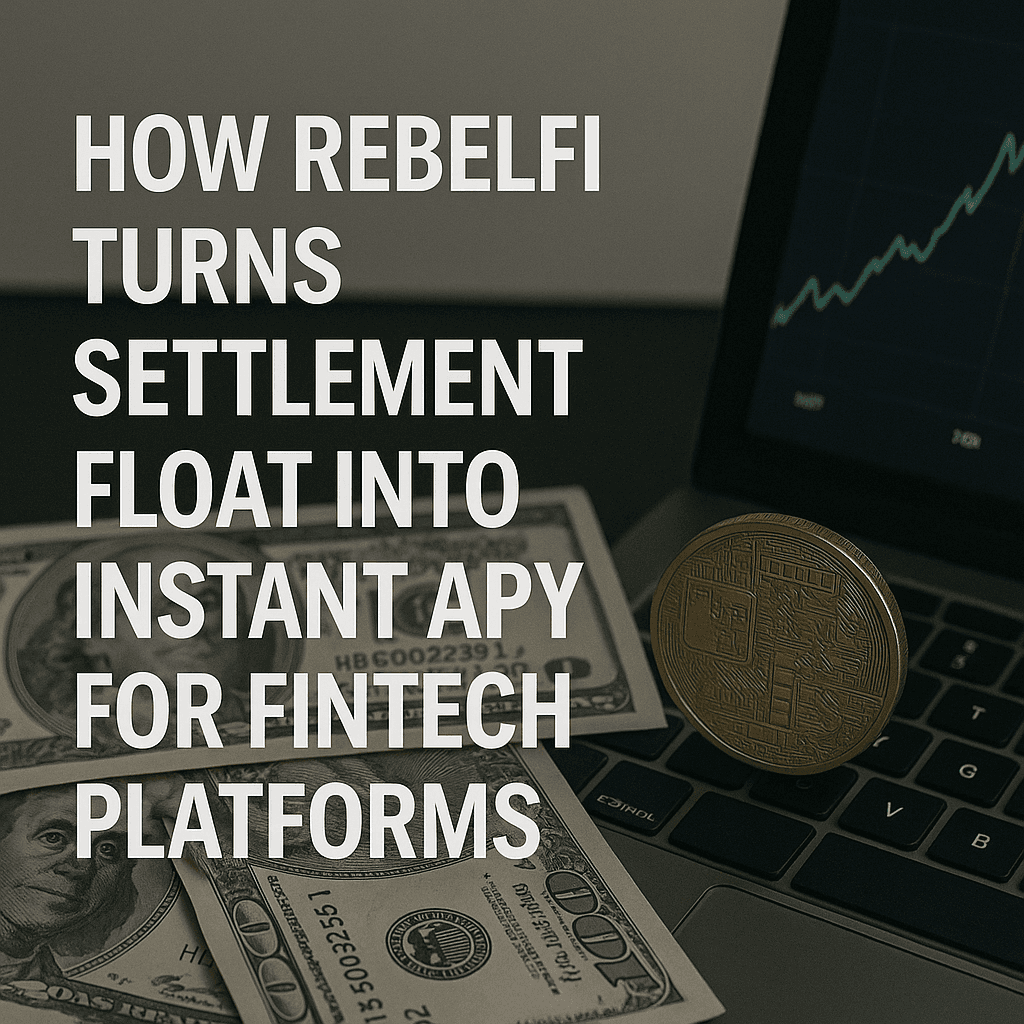Fintech platforms processing millions in payment volume daily are overlooking a significant revenue opportunity: settlement float. While traditional payment rails leave funds idle for 3-5 days earning 0%, modern fintech infrastructure transforms this capital into productive assets generating 6-9% APY automatically.
Settlement float is the time gap between payment initiation and final settlement. For payment processors, neobanks, and cross-border platforms, this can represent millions sitting dormant. RebelFi's programmable infrastructure converts this idle capital into yield-generating assets the moment funds arrive.
What is Settlement Float in Payment Processing?
Settlement float exists in every payment operation. When customers deposit funds, those assets sit in pooled accounts for hours or days before processing. Traditional banking treats this as operational overhead. Modern fintech infrastructure treats it as revenue opportunity.
The Math Behind Settlement Float Yield:
A cross-border payment platform processing $50M monthly with 3-day settlement maintains roughly $5M in float. At 0% yield, this generates nothing. With stablecoin infrastructure earning 7% APY, the same float produces $29,000 monthly or $350,000 annually.
Stablecoin transaction volumes surpassed $8.9 trillion in H1 2025, demonstrating the massive scale of capital flows that could benefit from yield optimization. Even small-to-medium fintechs processing $10M monthly maintain $800K average float, representing $56,000 annual opportunity at current yields.
Why Traditional Payment Infrastructure Can't Capture Float Yield
Traditional payment infrastructure operates on batch processing tied to business hours and holidays. Major payment companies still face gaps when different countries observe different holidays, creating periods where value cannot move through the system.
Three core problems limit traditional infrastructure:
Capital Inefficiency: Funds sit idle at 0% while yield-bearing stablecoins offer 8.3% APY, creating massive opportunity cost.
Operational Complexity: Managing float across multiple currencies and jurisdictions requires extensive manual oversight that could be automated.
Competitive Disadvantage: Competitors using programmable infrastructure generate automatic revenue from every transaction cycle.
The GENIUS Act passed in Q2 2025 established national stablecoin standards, accelerating institutional adoption and making stablecoin infrastructure viable for mainstream fintech operations.
How RebelFi Converts Payment Float into Instant APY
RebelFi's programmable infrastructure activates yield generation the moment funds arrive, not days later.
Instant Yield Activation
Traditional yield products require manual deposits and multi-day activation. RebelFi activates yield in the same transaction that receives funds. A $100,000 deposit begins earning within seconds through atomic integration with DeFi protocols.
The architecture leverages Solana's blockchain to execute operations at speeds impossible on traditional rails. Transactions completing in days for $50-100 finish in seconds for fractions of a penny.
Automated Flow Optimization
The system continuously analyzes deposit and withdrawal patterns to optimize capital deployment. Rather than static reserve ratios, infrastructure dynamically adjusts based on real-time liquidity needs and yield opportunities.
For predictable payment cycles, the system deploys larger portions into higher-yield strategies while maintaining sufficient liquid reserves. During high withdrawal activity, it automatically shifts more capital to instant-access positions.
Cross-Chain Settlement Support
RebelFi supports deposits and withdrawals across Ethereum, Base, Arbitrum, and Polygon. All funds efficiently process on Solana for yield generation, but users never need to understand underlying mechanics.
A European customer deposits USDC on Ethereum, the platform earns yield on Solana, and a Latin American recipient collects on Polygon. Cross-chain architecture eliminates user friction while maximizing operational efficiency.
Real-World Performance: Fintech Platform Case Studies
Payment Processor ($10M Monthly Volume):
Average float: $800K (2.5-day settlement)
Yield at 7% APY: $4,600 monthly, $56,000 annually
Previous earnings on float: $0
Neobank ($50M Customer Deposits):
Average overnight float: $1.5M (3%)
Yield at 7% APY: $8,750 monthly, $105,000 annually
Zero additional risk beyond existing stablecoin holdings
Cross-Border Platform ($100M Annual):
Average float: $11M (4-day settlement)
Yield at 7% APY: $64,000 monthly, $770,000 annually
Operational complexity reduced 60% through automation
These represent actual economics of converting settlement float using programmable infrastructure operating on Solana mainnet today.
Technical Infrastructure: Smart Contracts and DeFi Integration
Programmable Payment Architecture
RebelFi uses audited smart contracts managing fund deployment, yield generation, and automated reconciliation:
Programmable escrow holds funds until conditions are met, releasing based on triggers or milestones
Cancellable transfers allow senders to reverse before recipients claim, eliminating costly errors
Conditional releases execute payments based on oracle data, enabling sophisticated business logic
Smart contract transparency provides verification impossible with traditional banking. Every transaction, yield accrual, and fund movement exists on-chain with cryptographic proof.
DeFi Protocol Integration
Direct integration with institutional-grade protocols like Drift on Solana delivers 6-14% yields through established platforms processing billions in volume. The infrastructure makes these yields accessible without requiring blockchain expertise.
Yield generation happens automatically. No manual staking, no complex protocol interaction, no user error risk. Funds deploy, earn, compound, and remain available for instant withdrawal.
Security and Compliance
Production financial infrastructure demands institutional-grade security:
Smart contracts audited by leading security firms
Real-time protocol health monitoring with automatic migration if risks exceed parameters
Conservative strategies focusing on over-collateralized lending
Travel Rule automation, KYC/AML integration, and comprehensive audit trails
Strategic Advantages Beyond Direct Yield
Competitive Differentiation
Platforms using programmable infrastructure gain structural advantages. They offer better customer economics because operations generate revenue rather than just incurring costs.
Platform A using traditional infrastructure earns $0 on settlement float. Platform B using RebelFi generates $500,000 annually from float optimization. Platform B passes value to customers through better rates while improving margins.
Revenue Model Innovation
Programmable infrastructure enables new revenue models:
Zero-fee processing with yield-sharing where customers earn returns on balances
Negative-fee incentives where platforms pay customers for using services, funded by yield
Dynamic fee structures adjusting based on settlement timing and yield opportunities
Operational Efficiency
AI-driven automation in treasury management reduces reconciliation time by 60%. RebelFi amplifies these gains with real-time visibility across multiple chains and protocols.
Treasury teams get instant answers: current yield rate across positions, available liquidity for withdrawals, optimal deployment strategy for today's market conditions.
Why 2025 is the Inflection Point for Payment Float Yield
Regulatory Clarity
The GENIUS Act requires stablecoin issuers to hold reserves in insured institutions and undergo audits. Critically, the Act prohibits issuers from paying interest but places no restrictions on infrastructure providers like RebelFi.
This creates partnership opportunities: regulated institutions issue compliant stablecoins, RebelFi provides yield infrastructure. Banks gain differentiated offerings without violating regulations.
Scale of Opportunity
The stablecoin market exceeded $200 billion in total supply, with B2B flows annualizing over $36 billion. Every dollar represents potential settlement float that could generate yield.
Companies like BVNK, Rain, and Noah are building stablecoin payment rails for businesses. Platforms offering yield on settlement float will have decisive advantages.
Technical Readiness
Solana processes over 3,000 transactions per second at fractional penny costs, making complex financial operations economically viable at scale. Rain achieved fully automated seven-day-a-week settlement with Visa, proving blockchain infrastructure operates at institutional standards.
Implementation Path for Fintech Platforms
Phase 1: Assessment (Week 1-2)
Analyze settlement patterns to quantify float opportunity. Calculate average float balance, typical settlement duration, and current yield (likely zero). Model potential value at various APY rates.
Most small-to-medium platforms discover six-figure annual opportunities from float optimization.
Phase 2: Pilot Deployment (30-60 Days)
Start with limited volume processing specific corridors or customer segments. Validate technical integration, confirm yield matches projections, and build internal expertise.
Phase 3: Full Scale (60-90 Days)
Expand to full operational deployment. RebelFi infrastructure scales seamlessly from thousands to billions without architectural changes.
Phase 4: Advanced Features
Activate programmable capabilities:
Programmable escrow for marketplace operations
Milestone-based releases for B2B payments
Conditional transfers triggered by external data
Cross-border settlement optimization
Risk Management Considerations
Smart Contract Risk
Contracts undergo multiple independent security audits by leading firms. Conservative deployment focuses on battle-tested protocols with insurance options through Nexus Mutual.
Protocol Risk
Infrastructure diversifies across protocols and monitors health constantly. Automatic migration occurs if any protocol shows stress. Protocols offering yield-bearing stablecoins surpassed $6 billion TVL in Q1 2025.
Yield Volatility
DeFi yields fluctuate between 4-12% based on market conditions. Even at lower ranges, this dramatically outperforms 0% traditional settlement float yield.
Regulatory Evolution
Modular compliance architecture adapts to regulatory changes. Infrastructure includes Travel Rule compliance, KYC/AML integration, and comprehensive audit trails that expand with new requirements.
Competitive Positioning: RebelFi vs Traditional Infrastructure
Traditional Payment Processors
Bridge and BVNK excel at fiat on/off ramps but avoid programmable features. They treat stablecoins as faster payment rails, not programmable capital. Their business models optimize traditional banking connections rather than revolutionizing them.
Stablecoin Issuers
Circle's USDC provides stable, compliant tokens but leaves yield generation to users. Under the GENIUS Act, issuers cannot offer yield infrastructure, creating the perfect partnership opportunity for platforms like RebelFi.
DeFi Protocols
Aave and Compound offer excellent yields but require significant technical expertise. Mainstream fintechs cannot expect treasury teams to manually manage DeFi positions across multiple protocols and chains.
RebelFi's Unique Position
RebelFi sits at the intersection of DeFi yield sources and institutional fintech operations:
Institutional-grade security and compliance
Custody-agnostic architecture working with existing infrastructure
Automated optimization requiring no blockchain expertise
Production-ready APIs designed for fintech integration
Cross-chain support eliminating single-network lock-in
No other solution combines these capabilities for mainstream fintech adoption.
Frequently Asked Questions
How much can my platform earn from settlement float?
Calculate your average daily float and multiply by 7% APY. A platform with $1M average float earns approximately $70,000 annually. Most platforms processing $10M+ monthly have $500K-$2M in average float.
What's the implementation timeline?
Assessment: 1-2 weeks. Pilot deployment: 30-60 days. Full scale: 60-90 days. Most platforms begin seeing yield within 45 days of initial discussion.
Do we need to change custody providers?
No. RebelFi's custody-agnostic architecture works with Tatum, Fireblocks, BitGo, and other solutions. You maintain your existing security infrastructure.
What are the actual risks?
Smart contract risk (mitigated through audits and insurance), protocol risk (mitigated through diversification), and yield volatility (4-12% range still outperforms 0%). These risks are comparable to what you already accept holding stablecoins.
The Settlement Float Opportunity
Settlement float optimization represents a rare structural advantage in fintech: immediate measurable value that compounds over time and competitors cannot easily replicate.
Traditional payment infrastructure treats settlement float as unavoidable overhead. Programmable infrastructure treats it as productive capital earning 6-9% APY automatically.
The math is straightforward:
$1M average float = $70K annual yield
$5M average float = $350K annual yield
$10M average float = $700K annual yield
These numbers represent pure upside from capital currently earning zero return.
Fintechs adopting programmable settlement infrastructure gain:
Better customer economics through lower fees or yield sharing
Improved margins from automatic revenue generation
Operational efficiency through automated treasury management
Strategic advantage impossible for competitors using traditional rails
The infrastructure exists and operates in production today on Solana mainnet. It's proven, scalable, and ready for integration.
The question isn't whether settlement float optimization matters. The question is whether your platform will capture this value before your competitors do.
Start Converting Payment Float into Revenue
RebelFi's programmable infrastructure transforms every transaction into an opportunity. Settlement float shifts from idle capital into revenue-generating assets. Payment processing moves from cost center to profit source.
Ready to turn your settlement float into instant APY? Explore RebelFi's programmable infrastructure at rebelfi.io.



